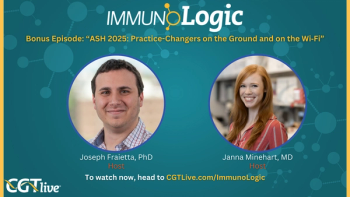
Zolgensma Shows Efficacy in SMA With 3 SMN2 Copies
Shephard Mpofu, MD, part of the Novartis Gene Therapies leadership, shared his thoughts on the latest phase 3 data on onasemnogene abeparvovec (Zolgensma) from the SPR1NT trial.
This content originally appeared on our sister site,
New data from the phase 3 SPR1NT trial (NCT03505099) of onasemnogene abeparvovec (Zolgensma; Novartis Gene Therapies) were recently published, suggesting that the therapy is efficacious for presymptomatic patients with spinal muscular atrophy (SMA) with 3 copies of SMN2. Additionally, the gene-splicing modifier was well-tolerated in this population.1,2
The results of the multicenter, open-label study were presented at the 2022 Muscular Dystrophy Association (MDA) Clinical and Scientific Conference, March 13-16, in Nashville, Tennessee.1 The dataset presented included 15 patients, with Zolgensma treatment meeting both primary and secondary end points statistical significance (P <.001). The therapy was compared with a cohort from the Pediatric Neuromuscular Clinical Research natural history data set.
Every patient was alive at the time of reporting, and no patients required ventilation or feeding tube support at any time point. Additionally, 100% of the treatment group achieved the ability to stand alone, and 93% (n = 14) of those patients achieved this within the World Health Organization (WHO) Multicentre Growth Reference Study (MGRS) developmental window. Fourteen patients walked alone—11 within the WHO-MGRS developmental window.1,2
As for safety, every patient reported an adverse event (AE), of which 53% (n = 8) had at least 1 treatment-related AE. Three patients reported serious AEs, but none were considered treatment-related by the investigators.
Shephard Mpofu, MD, senior vice president and chief medical officer, Novartis Gene Therapies, offered his perspective on the data in detail in this conversation, providing more context about the findings and their significance for the clinical community.
What should the clinical community take away from the data for the SPR1NT 3 copy cohort?
Shephard Mpofu, MD: The completed Phase 3 SPR1NT data presented at MDA show that children with three copies of the SMN2 back-up gene treated presymptomatically achieved age-appropriate milestones, including standing and walking. This is a stark contrast with the natural progression of SMA. Without treatment, most children with three copies of the SMN2 back-up gene develop SMA Type 2, characterized by the inability to walk independently. Results from SPR1NT reinforce that early treatment is critical regardless of medication and further demonstrates the outstanding impact Zolgensma can have on children with SMA.
Were there any particularly exciting data points or unique aspects of this assessment?
We are excited that the results from the SPR1NT trial once again confirm the transformative impact of Zolgensma for children with SMA, and now in patients who were treated presymptomatically.
Fourteen of 15 children (or 93%) went on to walk independently, most (11 of 15, or 73%) within the World Health Organization window of normal development. All 15 children met the primary end point of standing alone 3 or more seconds, including 14 of 15 (or 93%) within the WHO window of normal development. All children were free of feeding tube support and ventilatory support of any kind during the study, and no serious, treatment-related adverse events were reported
These results are in sharp contrast to the natural history of the disease—and they again reinforce the value of early diagnosis and treatment of SMA.
How would you describe the overall data profile on Zolgensma to this point?
Zolgensma has demonstrated consistent, transformative, and clinically meaningful therapeutic benefit in presymptomatic and symptomatic SMA, including prolonged event-free survival and achievement of motor milestones unseen in natural history of the disease.
The data presented at MDA continue to reinforce the benefit of Zolgensma in the real-world setting, including in patients outside of our current clinical trial experience.
What still needs to be understood?
We believe that all patients diagnosed with SMA should be able to benefit from the transformative impact of gene therapy, and we continue to study its effect in patient groups where unmet needs remain. The data presented at MDA continue to reinforce the benefit of Zolgensma in the real-world setting, including in patients outside of our current clinical trial experience.
In addition to the SPR1NT data, Novartis also presented a descriptive post hoc analyses of START, STR1VE-EU and STR1VE-US that indicated children with SMA Type 1 achieved or maintained important measures of bulbar function following treatment with Zolgensma, including ability to speak; swallow and meet nutritional needs; and maintain airway protection. Bulbar motor neurons control muscles required for functions like swallowing, speaking, and chewing, and impairment from SMA can lead to choking, malnutrition, infection and death.
In April 2021, we announced plans to initiate SMART, a phase 3b clinical study to evaluate the safety and efficacy of Zolgensma in young children with SMA weighing 8.5 kg or more and 21 kg or less. Additionally, in August 2021, we announced plans to initiate STEER, a global pivotal phase 3 registration-enabling study to evaluate the clinical efficacy, safety, and tolerability of OAV101 intrathecal in treatment-naïve patients who are between 2 and 18 years of age, able to sit, but have never walked.
Transcript edited for clarity.
REFERENCES
1. Strauss K, Mutoni F, Farrar MA, et al. Onasemnogene abeparvovec in presymptomatic spinal muscular atrophy: SPR1NT study update in children with three copies of SMN2. Presented at: MDA 2022; March 13-16; Nashville, TN. Virtual Poster. https://mdaconference.org/node/1708
2. Novartis data again demonstrate age-appropriate development when Zolgensma is used presymptomatically, and post-hoc data reveal SMA Type 1 patients could speak, swallow and maintain airway protection. News release. Novartis. March 14, 2022. Accessed April 11, 2022. https://www.novartis.com/news/media-releases/novartis-data-again-demonstrate-age-appropriate-development-when-zolgensma-used-presymptomatically-and-post-hoc-data-reveal-sma-type-1-patients-could-speak-swallow-and-maintain-airway-protection
Newsletter
Stay at the forefront of cutting-edge science with CGT—your direct line to expert insights, breakthrough data, and real-time coverage of the latest advancements in cell and gene therapy.





































